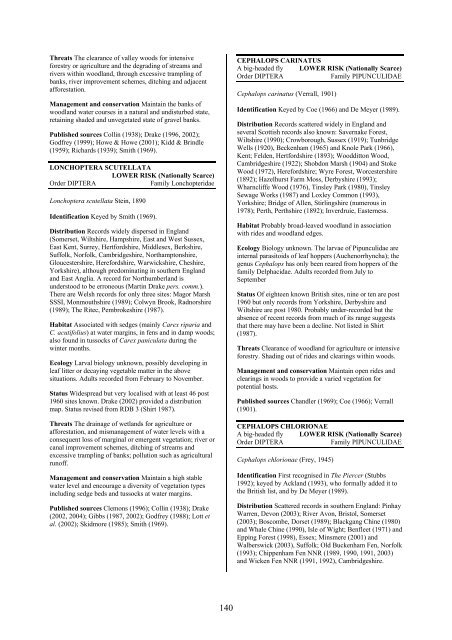Part 2: Nematocera and Aschiza not dealt with by Falk (1991) - JNCC
Part 2: Nematocera and Aschiza not dealt with by Falk (1991) - JNCC
Part 2: Nematocera and Aschiza not dealt with by Falk (1991) - JNCC
You also want an ePaper? Increase the reach of your titles
YUMPU automatically turns print PDFs into web optimized ePapers that Google loves.
Threats The clearance of valley woods for intensive<br />
forestry or agriculture <strong>and</strong> the degrading of streams <strong>and</strong><br />
rivers <strong>with</strong>in woodl<strong>and</strong>, through excessive trampling of<br />
banks, river improvement schemes, ditching <strong>and</strong> adjacent<br />
afforestation.<br />
Management <strong>and</strong> conservation Maintain the banks of<br />
woodl<strong>and</strong> water courses in a natural <strong>and</strong> undisturbed state,<br />
retaining shaded <strong>and</strong> unvegetated state of gravel banks.<br />
Published sources Collin (1938); Drake (1996, 2002);<br />
Godfrey (1999); Howe & Howe (2001); Kidd & Brindle<br />
(1959); Richards (1939); Smith (1969).<br />
LONCHOPTERA SCUTELLATA<br />
LOWER RISK (Nationally Scarce)<br />
Order DIPTERA<br />
Family Lonchopteridae<br />
Lonchoptera scutellata Stein, 1890<br />
Identification Keyed <strong>by</strong> Smith (1969).<br />
Distribution Records widely dispersed in Engl<strong>and</strong><br />
(Somerset, Wiltshire, Hampshire, East <strong>and</strong> West Sussex,<br />
East Kent, Surrey, Hertfordshire, Middlesex, Berkshire,<br />
Suffolk, Norfolk, Cambridgeshire, Northamptonshire,<br />
Gloucestershire, Herefordshire, Warwickshire, Cheshire,<br />
Yorkshire), although predominating in southern Engl<strong>and</strong><br />
<strong>and</strong> East Anglia. A record for Northumberl<strong>and</strong> is<br />
understood to be erroneous (Martin Drake pers. comm.).<br />
There are Welsh records for only three sites: Magor Marsh<br />
SSSI, Monmouthshire (1989); Colwyn Brook, Radnorshire<br />
(1989); The Ritec, Pembrokeshire (1987).<br />
Habitat Associated <strong>with</strong> sedges (mainly Carex riparia <strong>and</strong><br />
C. acutifolius) at water margins, in fens <strong>and</strong> in damp woods;<br />
also found in tussocks of Carex paniculata during the<br />
winter months.<br />
Ecology Larval biology unknown, possibly developing in<br />
leaf litter or decaying vegetable matter in the above<br />
situations. Adults recorded from February to November.<br />
Status Widespread but very localised <strong>with</strong> at least 46 post<br />
1960 sites known. Drake (2002) provided a distribution<br />
map. Status revised from RDB 3 (Shirt 1987).<br />
Threats The drainage of wetl<strong>and</strong>s for agriculture or<br />
afforestation, <strong>and</strong> mismanagement of water levels <strong>with</strong> a<br />
consequent loss of marginal or emergent vegetation; river or<br />
canal improvement schemes, ditching of streams <strong>and</strong><br />
excessive trampling of banks; pollution such as agricultural<br />
runoff.<br />
Management <strong>and</strong> conservation Maintain a high stable<br />
water level <strong>and</strong> encourage a diversity of vegetation types<br />
including sedge beds <strong>and</strong> tussocks at water margins.<br />
Published sources Clemons (1996); Collin (1938); Drake<br />
(2002, 2004); Gibbs (1987, 2002); Godfrey (1988); Lott et<br />
al. (2002); Skidmore (1985); Smith (1969).<br />
CEPHALOPS CARINATUS<br />
A big-headed fly LOWER RISK (Nationally Scarce)<br />
Order DIPTERA<br />
Family PIPUNCULIDAE<br />
Cephalops carinatus (Verrall, 1901)<br />
Identification Keyed <strong>by</strong> Coe (1966) <strong>and</strong> De Meyer (1989).<br />
Distribution Records scattered widely in Engl<strong>and</strong> <strong>and</strong><br />
several Scottish records also known: Savernake Forest,<br />
Wiltshire (1990); Crowborough, Sussex (1919); Tunbridge<br />
Wells (1920), Beckenham (1965) <strong>and</strong> Knole Park (1966),<br />
Kent; Felden, Hertfordshire (1893); Woodditton Wood,<br />
Cambridgeshire (1922); Shobdon Marsh (1904) <strong>and</strong> Stoke<br />
Wood (1972), Herefordshire; Wyre Forest, Worcestershire<br />
(1892); Hazelhurst Farm Moss, Der<strong>by</strong>shire (1993);<br />
Wharncliffe Wood (1976), Tinsley Park (1980), Tinsley<br />
Sewage Works (1987) <strong>and</strong> Loxley Common (1993),<br />
Yorkshire; Bridge of Allen, Stirlingshire (numerous in<br />
1978); Perth, Perthshire (1892); Inverdruie, Easterness.<br />
Habitat Probably broad-leaved woodl<strong>and</strong> in association<br />
<strong>with</strong> rides <strong>and</strong> woodl<strong>and</strong> edges.<br />
Ecology Biology unknown. The larvae of Pipunculidae are<br />
internal parasitoids of leaf hoppers (Auchenorrhyncha); the<br />
genus Cephalops has only been reared from hoppers of the<br />
family Delphacidae. Adults recorded from July to<br />
September<br />
Status Of eighteen known British sites, nine or ten are post<br />
1960 but only records from Yorkshire, Der<strong>by</strong>shire <strong>and</strong><br />
Wiltshire are post 1980. Probably under-recorded but the<br />
absence of recent records from much of its range suggests<br />
that there may have been a decline. Not listed in Shirt<br />
(1987).<br />
Threats Clearance of woodl<strong>and</strong> for agriculture or intensive<br />
forestry. Shading out of rides <strong>and</strong> clearings <strong>with</strong>in woods.<br />
Management <strong>and</strong> conservation Maintain open rides <strong>and</strong><br />
clearings in woods to provide a varied vegetation for<br />
potential hosts.<br />
Published sources Ch<strong>and</strong>ler (1969); Coe (1966); Verrall<br />
(1901).<br />
CEPHALOPS CHLORIONAE<br />
A big-headed fly LOWER RISK (Nationally Scarce)<br />
Order DIPTERA<br />
Family PIPUNCULIDAE<br />
Cephalops chlorionae (Frey, 1945)<br />
Identification First recognised in The Piercer (Stubbs<br />
1992); keyed <strong>by</strong> Ackl<strong>and</strong> (1993), who formally added it to<br />
the British list, <strong>and</strong> <strong>by</strong> De Meyer (1989).<br />
Distribution Scattered records in southern Engl<strong>and</strong>: Pinhay<br />
Warren, Devon (2003); River Avon, Bristol, Somerset<br />
(2003); Boscombe, Dorset (1989); Blackgang Chine (1980)<br />
<strong>and</strong> Whale Chine (1990), Isle of Wight; Benfleet (1971) <strong>and</strong><br />
Epping Forest (1998), Essex; Minsmere (2001) <strong>and</strong><br />
Walberswick (2003), Suffolk; Old Buckenham Fen, Norfolk<br />
(1993); Chippenham Fen NNR (1989, 1990, <strong>1991</strong>, 2003)<br />
<strong>and</strong> Wicken Fen NNR (<strong>1991</strong>, 1992), Cambridgeshire.<br />
140
















